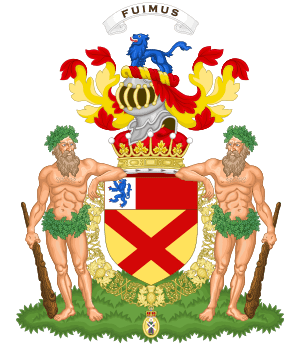Earl of Elgin facts for kids
Quick facts for kids Earldom of Elginheld with Earldom of Kincardine |
|
|---|---|

Or, a saltire and chief gules on a canton argent a lion rampant azure armed and langued of the second
|
|
| Creation date | 21 June 1633 |
| Monarch | Charles I |
| Peerage | Peerage of Scotland |
| First holder | Thomas Bruce, 3rd Lord Kinloss |
| Present holder | Andrew Bruce, 11th Earl of Elgin |
| Heir apparent | Charles Bruce, Lord Bruce |
| Remainder to | Heirs male forever, bearing the name Bruce |
| Subsidiary titles | Baron Elgin Lord Bruce of Kinloss Lord Bruce of Torry |
| Seat(s) | Broomhall House |
| Motto | Fuimus ("We have been") |
The Earl of Elgin is an important title in Scotland. It was first created in 1633 for Thomas Bruce. This title is part of the Peerage of Scotland, which is a system of noble ranks in Scotland. The Earl of Elgin is also the traditional leader, or Clan Chief, of Clan Bruce.
Contents
A Look Back at the Earls of Elgin
The family holding the title of Earl of Elgin comes from the Bruce family of Clackmannan. Their ancestor was Thomas de Bruys. While some people thought this family branch was related to Robert the Bruce, who was King Robert I of Scotland, there is no clear proof. However, King Robert's son, David II, did call a later Robert Bruce his "beloved cousin" in 1359.
How the Titles Changed Over Time
The first Earl of Elgin was followed by his son, Robert. Robert was also given the title of Earl of Ailesbury in the Peerage of England. For a while, both Earldoms were held by the same person.
However, when the fourth Earl of Elgin passed away, the Ailesbury title ended. The Elgin title then went to the Earl of Kincardine. Since then, the Earldoms of Elgin and Kincardine have been held together by the same person.
Famous Earls and Their Legacies
One of the most well-known Earls was Thomas Bruce, the 7th Earl. He is famous for bringing the ancient Greek sculptures, known as the Elgin Marbles, from the Parthenon in Greece to Britain.
Another important figure was James Bruce, the 8th Earl. He served as a diplomat and governor in different parts of the world, including Canada and India.
Other Titles Held by the Earl
Besides being the Earl of Elgin and Earl of Kincardine, the current Earl also holds several other titles. These include Lord Bruce of Kinloss (created in 1604) and Lord Bruce of Torry (created in 1647). Both of these are Scottish titles. He also holds the title Baron Elgin, of Elgin in Scotland (created in 1849), which is a title in the Peerage of the United Kingdom.
The family's main home is Broomhall House. It is located about three miles southwest of Dunfermline, Scotland.
Earls of Elgin (1633)
- Thomas Bruce, 1st Earl of Elgin, 1st Baron Bruce of Whorlton (1599–1663)
- Robert Bruce, 2nd Earl of Elgin, 1st Earl of Ailesbury, 2nd Baron Bruce of Whorlton (1627–1685)
- Thomas Bruce, 3rd Earl of Elgin, 2nd Earl of Ailesbury, 3rd Baron Bruce of Whorlton (1656–1741)
- Charles Bruce, 4th Earl of Elgin, 3rd Earl of Ailesbury, 4th Baron Bruce of Whorlton, 1st Baron Bruce of Skelton (1682–1747)
- Charles Bruce, 5th Earl of Elgin and 9th Earl of Kincardine (1732–1771)
- William Robert Bruce, 6th Earl of Elgin and 10th Earl of Kincardine (1764–1771)
- Thomas Bruce, 7th Earl of Elgin, 11th Earl of Kincardine (1766–1841) – known for the Elgin Marbles
- James Bruce, 8th Earl of Elgin, 12th Earl of Kincardine (1811–1863) – a notable diplomat
- Victor Alexander Bruce, 9th Earl of Elgin, 13th Earl of Kincardine (1849–1917)
- Edward James Bruce, 10th Earl of Elgin, 14th Earl of Kincardine (1881–1968)
- Andrew Douglas Alexander Thomas Bruce, 11th Earl of Elgin, 15th Earl of Kincardine (born 1924)
The person who is expected to inherit the title next is the current Earl's son, Charles Edward Bruce, Lord Bruce (born 1961). His son, James Andrew Charles Robert Bruce, Master of Bruce (born 1991), is next in line after him.
Family tree
| Earls and Marquesses of Ailesbury, Earls of Cardigan, Earls of Elgin, and Earls of Kincardine family tree | |||||||||||||||||||||||||||||||||||||||||||||||||||||||||||||||||||||||||||||||||||||||||||||||||||||||||||||||||||||||||||||||||||||||||||||||||||||||||||||||||||||||||||||||||||||||||||||||||||||||||||||||||||||||||||||||||||||||||||||||||||||||||||||||||||||||||||||||||||||||||||||||||||||||||||||||||||||||||||||||||||||||||||||||||||||||||||||||||||||||||||||||||||||||||||||||||||||||||||||||||||||||||||||||||||||||||||||||||||||||||||||||||||||||||||||||||||||||||||||||||||||||||||||||||||||||||||||||||||||||||||||||||||||||||||||||||||||||||||||||||||||||||||||||||||||||||||||||||||||||||||||||||||||||||||||||||||||||||||||||||||||||||||||||||||||||||||||||||||||||||||||||||||||||||||||||||||||||||||||||||||||||||||||||||||||||||||||||||||||||||||||||||||||||||||||||||||||||||||||||||||||||||||||||||||||||||||||||||||||||||||||||||||||||||||||||||||||||||||||||||||||||||||||||||||||||||||||||||||||||||||||||||||||||||||||||||||||||||||||||||||||||||||||||||||||||||||||||||||||||
|---|---|---|---|---|---|---|---|---|---|---|---|---|---|---|---|---|---|---|---|---|---|---|---|---|---|---|---|---|---|---|---|---|---|---|---|---|---|---|---|---|---|---|---|---|---|---|---|---|---|---|---|---|---|---|---|---|---|---|---|---|---|---|---|---|---|---|---|---|---|---|---|---|---|---|---|---|---|---|---|---|---|---|---|---|---|---|---|---|---|---|---|---|---|---|---|---|---|---|---|---|---|---|---|---|---|---|---|---|---|---|---|---|---|---|---|---|---|---|---|---|---|---|---|---|---|---|---|---|---|---|---|---|---|---|---|---|---|---|---|---|---|---|---|---|---|---|---|---|---|---|---|---|---|---|---|---|---|---|---|---|---|---|---|---|---|---|---|---|---|---|---|---|---|---|---|---|---|---|---|---|---|---|---|---|---|---|---|---|---|---|---|---|---|---|---|---|---|---|---|---|---|---|---|---|---|---|---|---|---|---|---|---|---|---|---|---|---|---|---|---|---|---|---|---|---|---|---|---|---|---|---|---|---|---|---|---|---|---|---|---|---|---|---|---|---|---|---|---|---|---|---|---|---|---|---|---|---|---|---|---|---|---|---|---|---|---|---|---|---|---|---|---|---|---|---|---|---|---|---|---|---|---|---|---|---|---|---|---|---|---|---|---|---|---|---|---|---|---|---|---|---|---|---|---|---|---|---|---|---|---|---|---|---|---|---|---|---|---|---|---|---|---|---|---|---|---|---|---|---|---|---|---|---|---|---|---|---|---|---|---|---|---|---|---|---|---|---|---|---|---|---|---|---|---|---|---|---|---|---|---|---|---|---|---|---|---|---|---|---|---|---|---|---|---|---|---|---|---|---|---|---|---|---|---|---|---|---|---|---|---|---|---|---|---|---|---|---|---|---|---|---|---|---|---|---|---|---|---|---|---|---|---|---|---|---|---|---|---|---|---|---|---|---|---|---|---|---|---|---|---|---|---|---|---|---|---|---|---|---|---|---|---|---|---|---|---|---|---|---|---|---|---|---|---|---|---|---|---|---|---|---|---|---|---|---|---|---|---|---|---|---|---|---|---|---|---|---|---|---|---|---|---|---|---|---|---|---|---|---|---|---|---|---|---|---|---|---|---|---|---|---|---|---|---|---|---|---|---|---|---|---|---|---|---|---|---|---|---|---|---|---|---|---|---|---|---|---|---|---|---|---|---|---|---|---|---|---|---|---|---|---|---|---|---|---|---|---|---|---|---|---|---|---|---|---|---|---|---|---|---|---|---|---|---|---|---|---|---|---|---|---|---|---|---|---|---|---|---|---|---|---|---|---|---|---|---|---|---|---|---|---|---|---|---|---|---|---|---|---|---|---|---|---|---|---|---|---|---|---|---|---|---|---|---|---|---|---|---|---|---|---|---|---|---|---|---|---|---|---|---|---|---|---|---|---|---|---|---|---|---|---|---|---|---|---|---|---|---|---|---|---|---|---|---|---|---|---|---|---|---|---|---|---|---|---|---|---|---|---|---|---|---|---|---|---|---|---|---|---|---|---|---|---|---|---|---|---|---|---|---|---|---|---|---|---|---|---|---|---|---|---|---|---|---|---|---|---|---|---|---|---|---|---|---|---|---|---|---|---|---|---|---|---|---|---|---|---|---|---|---|---|---|---|---|---|---|---|---|---|---|---|---|---|---|---|---|---|---|---|---|---|---|---|---|---|---|---|---|---|---|---|---|---|---|---|---|---|---|---|---|---|---|---|---|---|---|---|---|---|---|---|---|---|---|---|---|---|---|---|---|---|---|---|---|---|---|---|---|---|---|---|---|---|---|---|---|---|---|---|---|---|---|---|---|---|---|---|---|---|---|---|---|---|---|---|---|---|---|---|---|---|---|---|---|---|---|---|---|---|---|---|---|---|---|---|---|---|---|---|---|---|---|---|---|---|---|---|---|---|---|---|---|---|---|---|---|---|---|---|---|---|---|---|---|---|---|---|---|---|---|---|---|---|---|---|---|---|---|---|---|---|---|---|---|---|---|---|---|---|---|---|---|---|---|---|---|---|---|---|---|---|---|---|---|---|---|---|---|---|---|---|---|---|---|---|---|---|---|---|---|---|---|---|---|---|---|---|---|---|---|---|---|---|---|---|---|---|---|---|---|---|---|---|---|---|---|---|---|---|---|---|---|---|---|---|---|---|---|---|---|---|---|---|---|---|---|---|---|---|---|---|---|---|---|---|---|---|---|---|---|---|---|---|---|---|---|---|---|---|
|
|||||||||||||||||||||||||||||||||||||||||||||||||||||||||||||||||||||||||||||||||||||||||||||||||||||||||||||||||||||||||||||||||||||||||||||||||||||||||||||||||||||||||||||||||||||||||||||||||||||||||||||||||||||||||||||||||||||||||||||||||||||||||||||||||||||||||||||||||||||||||||||||||||||||||||||||||||||||||||||||||||||||||||||||||||||||||||||||||||||||||||||||||||||||||||||||||||||||||||||||||||||||||||||||||||||||||||||||||||||||||||||||||||||||||||||||||||||||||||||||||||||||||||||||||||||||||||||||||||||||||||||||||||||||||||||||||||||||||||||||||||||||||||||||||||||||||||||||||||||||||||||||||||||||||||||||||||||||||||||||||||||||||||||||||||||||||||||||||||||||||||||||||||||||||||||||||||||||||||||||||||||||||||||||||||||||||||||||||||||||||||||||||||||||||||||||||||||||||||||||||||||||||||||||||||||||||||||||||||||||||||||||||||||||||||||||||||||||||||||||||||||||||||||||||||||||||||||||||||||||||||||||||||||||||||||||||||||||||||||||||||||||||||||||||||||||||||||||||||||||
See also

